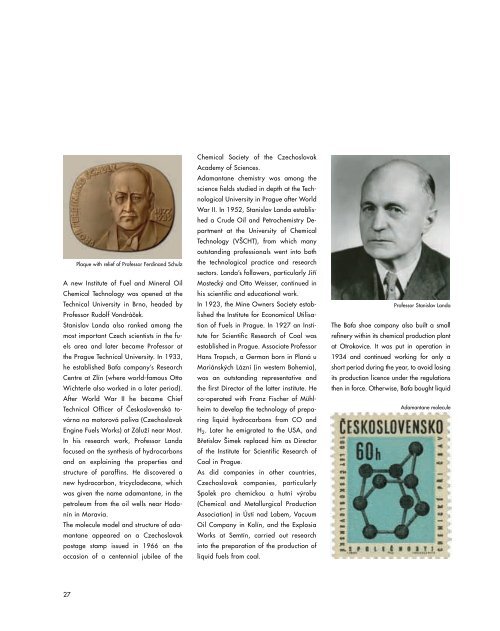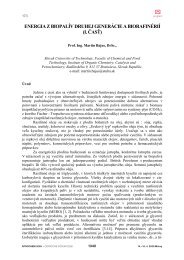THE CENTURY OF PETROL - Petroleum.cz
THE CENTURY OF PETROL - Petroleum.cz
THE CENTURY OF PETROL - Petroleum.cz
You also want an ePaper? Increase the reach of your titles
YUMPU automatically turns print PDFs into web optimized ePapers that Google loves.
A new Institute of Fuel and Mineral Oil<br />
Chemical Technology was opened at the<br />
Technical University in Brno, headed by<br />
Professor Rudolf Vondráãek.<br />
Stanislav Landa also ranked among the<br />
most important Czech scientists in the fuels<br />
area and later became Professor at<br />
the Prague Technical University. In 1933,<br />
he established BaÈa company’s Research<br />
Centre at Zlín (where world-famous Otto<br />
Wichterle also worked in a later period).<br />
After World War II he became Chief<br />
Technical Officer of âeskoslovenská továrna<br />
na motorová paliva (Czechoslovak<br />
Engine Fuels Works) at ZáluÏí near Most.<br />
In his research work, Professor Landa<br />
focused on the synthesis of hydrocarbons<br />
and on explaining the properties and<br />
structure of paraffins. He discovered a<br />
new hydrocarbon, tricyclodecane, which<br />
was given the name adamantane, in the<br />
petroleum from the oil wells near Hodonín<br />
in Moravia.<br />
The molecule model and structure of adamantane<br />
appeared on a Czechoslovak<br />
postage stamp issued in 1966 on the<br />
occasion of a centennial jubilee of the<br />
27<br />
Plaque with relief of Professor Ferdinand Schulz<br />
Chemical Society of the Czechoslovak<br />
Academy of Sciences.<br />
Adamantane chemistry was among the<br />
science fields studied in depth at the Technological<br />
University in Prague after World<br />
War II. In 1952, Stanislav Landa established<br />
a Crude Oil and Petrochemistry Department<br />
at the University of Chemical<br />
Technology (V·CHT), from which many<br />
outstanding professionals went into both<br />
the technological practice and research<br />
sectors. Landa’s followers, particularly Jifií<br />
Mosteck˘ and Otto Weisser, continued in<br />
his scientific and educational work.<br />
In 1923, the Mine Owners Society established<br />
the Institute for Economical Utilisation<br />
of Fuels in Prague. In 1927 an Institute<br />
for Scientific Research of Coal was<br />
established in Prague. Associate Professor<br />
Hans Tropsch, a German born in Planá u<br />
Mariánsk˘ch Lázní (in western Bohemia),<br />
was an outstanding representative and<br />
the first Director of the latter institute. He<br />
co-operated with Franz Fischer of Mühlheim<br />
to develop the technology of preparing<br />
liquid hydrocarbons from CO and<br />
H2. Later he emigrated to the USA, and<br />
Bfietislav ·imek replaced him as Director<br />
of the Institute for Scientific Research of<br />
Coal in Prague.<br />
As did companies in other countries,<br />
Czechoslovak companies, particularly<br />
Spolek pro chemickou a hutní v˘robu<br />
(Chemical and Metallurgical Production<br />
Association) in Ústí nad Labem, Vacuum<br />
Oil Company in Kolín, and the Explosia<br />
Works at Semtín, carried out research<br />
into the preparation of the production of<br />
liquid fuels from coal.<br />
Professor Stanislav Landa<br />
The BaÈa shoe company also built a small<br />
refinery within its chemical production plant<br />
at Otrokovice. It was put in operation in<br />
1934 and continued working for only a<br />
short period during the year, to avoid losing<br />
its production licence under the regulations<br />
then in force. Otherwise, BaÈa bought liquid<br />
Adamantane molecule



